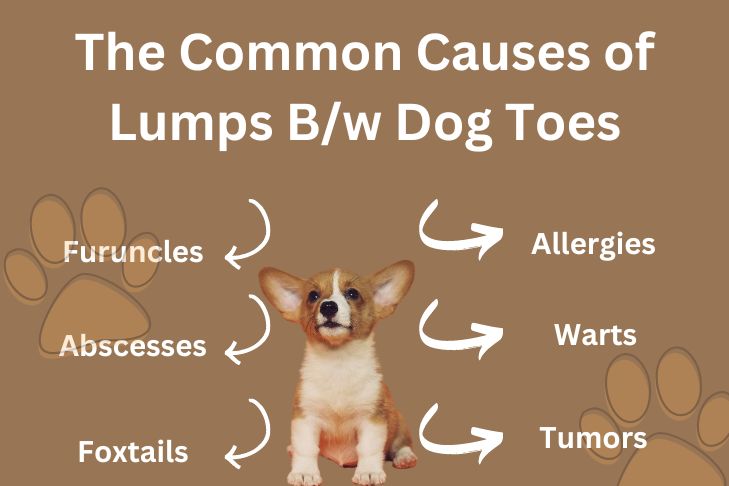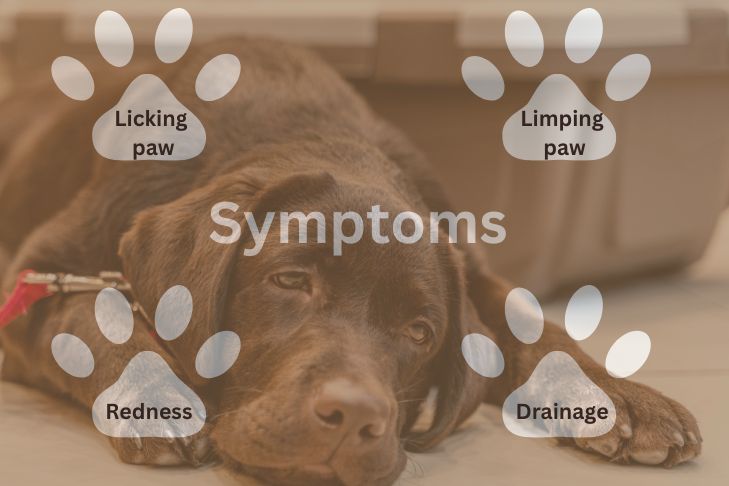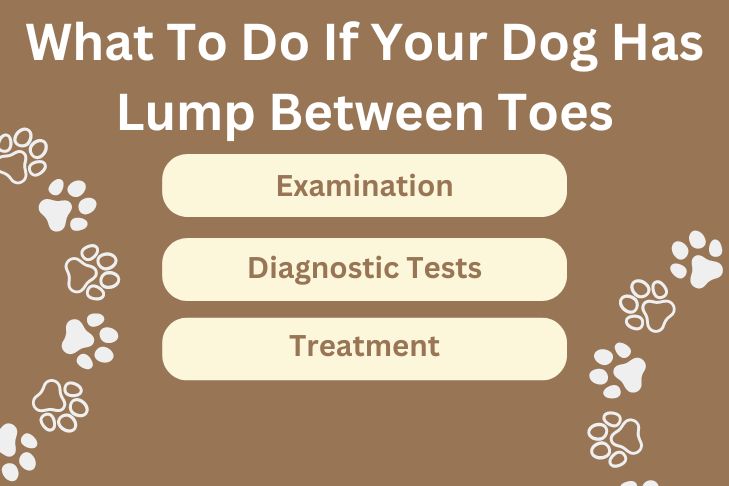Have you noticed a lump between your dog’s toes? It can be alarming to discover a new bump on your furry friend, especially on their delicate paws. While lumps and bumps can be caused by a variety of reasons, some more concerning than others, it’s important to understand what might be causing the lump and how to address it.
So, if your dog has lump between toes, this blog post will delve into the potential causes, the symptoms to watch out for, and the recommended course of action.
So, let’s get into it!
6 Most Common Causes of Lumps Between Dog Toes

There are several reasons why your dog might develop a lump between their toes. Here’s a breakdown of the most common culprits:
Interdigital cysts (furuncles):
These are the most frequent reasons why your dog has lump between toes. They are essentially inflamed and infected hair follicles. Fluffy little dogs’ breeds with short, coarse fur, like Shar-Peis, Bulldogs, and Labradors, are more prone to them due to ingrown hairs in the webbing between their toes. These cysts can be quite painful and often cause your dog to lick or chew at the affected area.
Abscesses:
Similar to interdigital cysts, abscesses are also localized pockets of pus caused by bacterial infection. They can develop from a variety of things, including a foreign object like a thorn or a splinter lodged in the paw pad, a bite or scratch that becomes infected, or even a neglected interdigital cyst. Abscesses are typically red, swollen, and quite painful for your dog.
Foxtails:
These barbed grass awns can burrow into your dog’s paw and migrate, causing irritation, infection, and potentially lump formation. Foxtails are particularly common in certain regions and during specific times of the year.
Allergies:
Environmental allergies or food sensitivities can manifest as itchy, inflamed skin between the toes, which can sometimes appear as lumps. These allergic reactions often cause excessive licking and chewing, which can worsen the irritation.
Warts:
While less common, warts can also develop between cute dogs toes. Typically, non-cancerous growths are caused by the canine papillomavirus. They usually appear as small, rough bumps and are rarely a cause for concern.
Read about: Chemotherapy in dogs
Tumors:
In rare cases, a lump between the toes could be a tumor. While not always cancerous, it’s important to have any suspicious lumps checked out by a veterinarian to determine the best course of action.
Symptoms To Check To Avoid Your Dog Has Lump In Toes!

While a lump itself might be the initial sign you notice, here are some additional symptoms to be aware of as a dog lover:
- Licking or Chewing at the Paw: This is a common response to discomfort or itchiness caused by the lump. Excessive licking can further irritate the area and potentially lead to infection.
- Limping or Favoring the Paw: Pain is a significant indicator that something is wrong. If your dog is limping or avoiding putting weight on the affected paw, it’s a sign they’re in discomfort and need veterinary attention.
- Redness, Swelling, or Pus: These signs point towards inflammation or infection and require a vet visit.
- Drainage: If the lump bursts or leaks pus, it’s likely an abscess and needs professional treatment.
What to Do if Your Dog has Lump Between Toes

If you discover a lump between your dog’s toes, the best course of action is to schedule an appointment with your veterinarian. They can thoroughly examine the lump, determine the cause, and recommend the most appropriate treatment plan for your chunky dog.
Here’s what to expect at the vet:
- Examination: The vet will closely examine the lump, including its size, location, and appearance. They might gently press on it to assess the pain and feel for any unusual textures.
- Diagnostic Tests: Depending on the suspected cause, the vet might recommend additional tests like cytology (analysis of cells from the lump) or a biopsy (tissue sample) to confirm the diagnosis in your furry little pup.
- Treatment: Treatment will vary depending on the cause of the lump. For interdigital cysts, antibiotics and potentially a medicated shampoo might be prescribed. Abscesses typically require lancing and drainage, followed by antibiotics.
Foxtails and foreign objects need removal, and any underlying infections will be addressed. Allergies might require dietary changes or medication to manage the underlying cause. In the case of tumors, the vet will discuss treatment options based on the type and severity.
Read More About Pup’s Health: Lochia in Dogs
Conclusion
If your dog has lumps between toes, it can be caused by various factors, some more concerning than others. If you notice a lump, don’t hesitate to schedule a vet visit for a proper diagnosis and treatment. By prioritizing preventative measures like regular paw care and addressing any underlying allergies, you can help your furry friend maintain healthy, happy paws.




